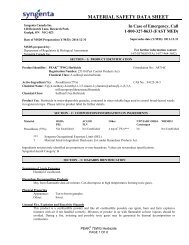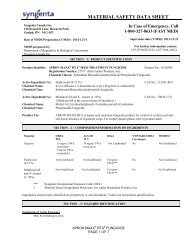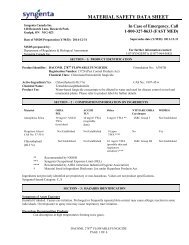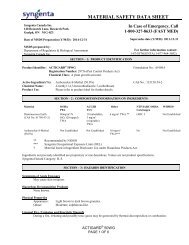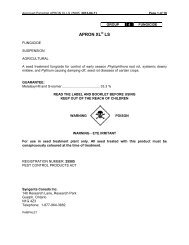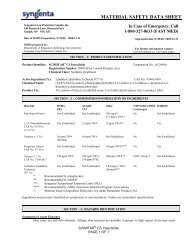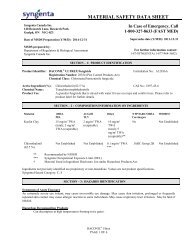A17712C pamphlet - Syngenta Farm
A17712C pamphlet - Syngenta Farm
A17712C pamphlet - Syngenta Farm
- No tags were found...
You also want an ePaper? Increase the reach of your titles
YUMPU automatically turns print PDFs into web optimized ePapers that Google loves.
Approved Pamphlet AXIAL XTREME 30391 2013-10-31 Page 5 of 9AXIAL XTREME Herbicide can be used on all varieties of spring wheat and barley.One application per year is permitted.Do not apply by air.Observe a minimum interval to harvest of 60 days after treatment for grain and straw and of 30days after treatment for hay. Observe a minimum of 7 days before grazing livestock on cropstreated with AXIAL XTREME Herbicide.Do not apply on any crop other than spring wheat or barley, as crop damage will result. Do notallow spray to drift to adjacent fields seeded to crops other than spring wheat or barley. Do nottreat spring wheat or barley under-seeded to forages. Do not apply AXIAL XTREME Herbicideon highly sensitive crops such as: tame oats, proso millet, red millet, crown millet or canaryseed.Field sprayer application: DO NOT apply during periods of dead calm. Avoid application of thisproduct when winds are gusty. DO NOT apply with spray droplets smaller than the AmericanSociety of Agricultural Engineers (ASAE) coarse classification. Boom height must be 60 cm orless above the crop or ground.For application to rights-of-way, buffer zones for protection of sensitive terrestrial habitats arenot required; however, the best available application strategies which minimize off-site drift,including meteorological conditions (e.g., wind direction, low wind speed) and spray equipment(e.g., coarse droplet sizes, minimizing height above canopy), should be used. Applicators must,however, observe the specified buffer zones for protection of sensitive aquatic habitats.Buffer zonesThe buffer zones specified in the table below are required between the point of directapplication and the closest downwind edge of sensitive terrestrial habitats (such as grasslands,forested areas, shelter belts, woodlots, hedgerows, riparian areas and shrublands), sensitivefreshwater habitats (such as lakes, rivers, sloughs, ponds, prairie potholes, creeks, marshes,streams, reservoirs and wetlands) and estuarine/marine habitats.Method ofBuffer Zones (metres) Required for the Protection ofCropapplicationTerrestrial and Aquatic HabitatsField sprayer* Spring wheat and barley 15*For field sprayer application, buffer zones can be reduced with the use of drift reducing spray shields.When using a spray boom fitted with a full shield (shroud, curtain) that extends to the crop canopy, thelabelled buffer zone can be reduced by 70%. When using a spray boom where individual nozzles are fittedwith cone-shaped shields that are no more than 30 cm above the crop canopy, the labelled buffer zonecan be reduced by 30%.When a tank mixture is used, consult the labels of the tank-mix partners and observe thelargest (most restrictive) buffer zone of the products involved in the tank mixture.ROTATIONAL CROP INFORMATIONFields previously treated with AXIAL XTREME can be seeded the following year to barley,canola, flax, forage grasses, lentils, mustard, oats, peas, rye or wheat or fields can be



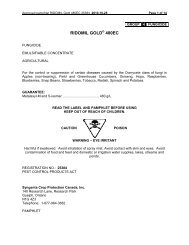
![gesagard 480sc [pamphlet] - Syngenta Crop Protection](https://img.yumpu.com/50945984/1/190x245/gesagard-480sc-pamphlet-syngenta-crop-protection.jpg?quality=85)
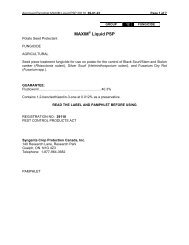
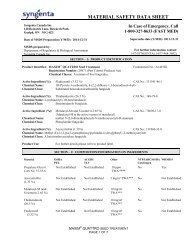
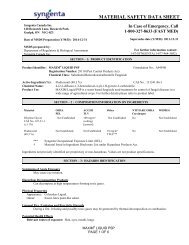
![ridomil Gold mz 68wp [bag] - Syngenta Farm](https://img.yumpu.com/49025229/1/190x245/ridomil-gold-mz-68wp-bag-syngenta-farm.jpg?quality=85)
